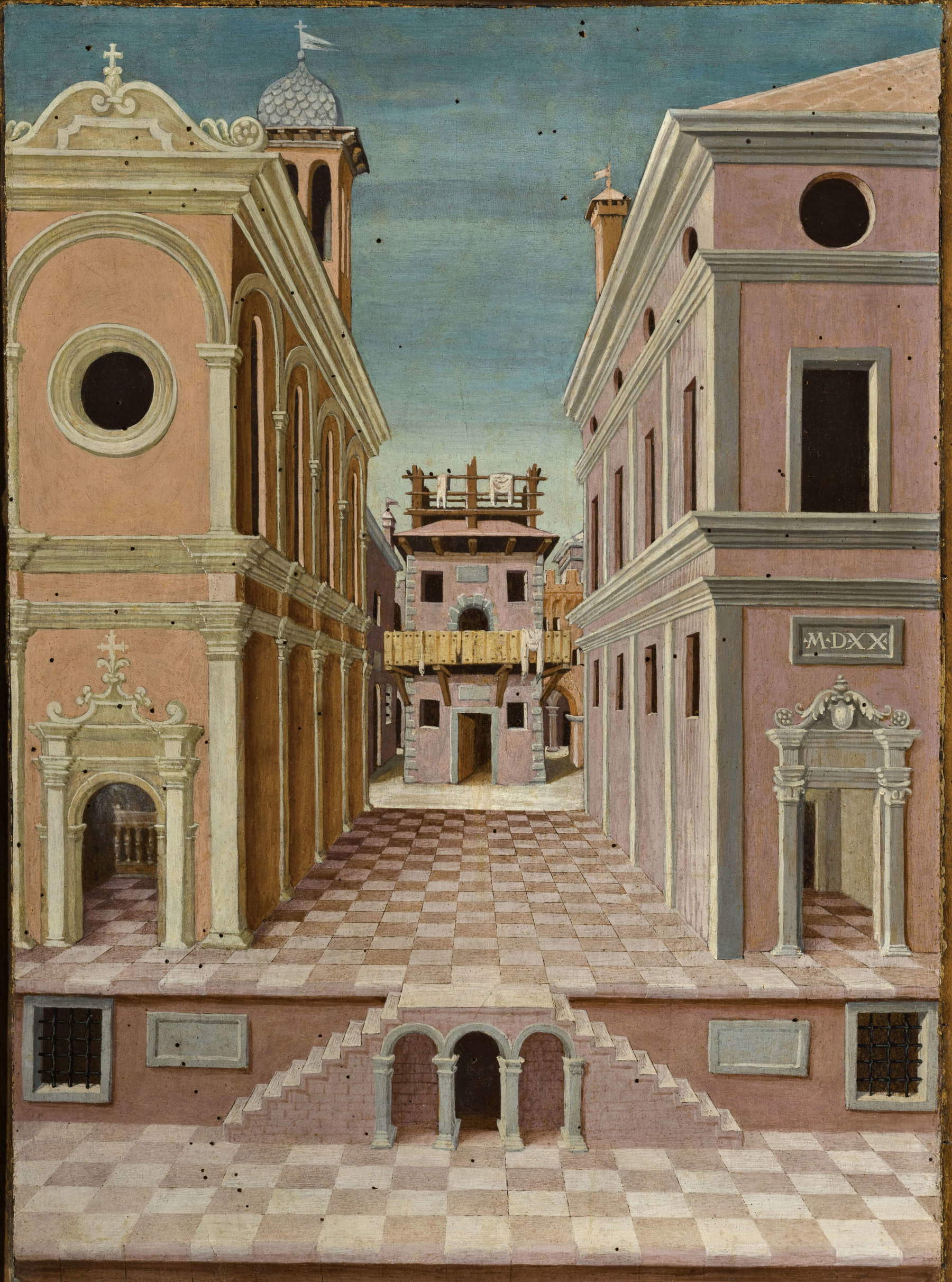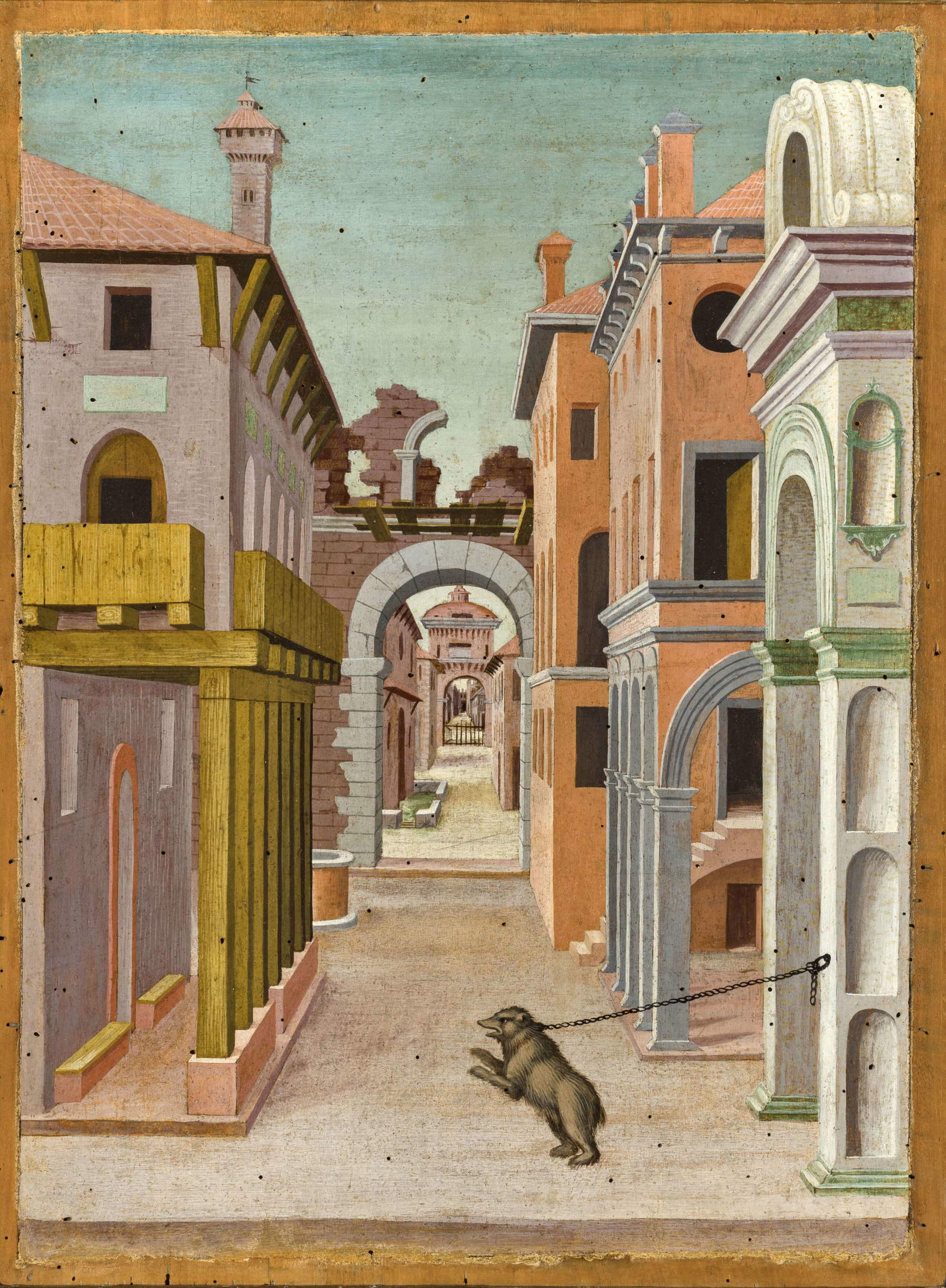A chained bear, tied to the facade of an elegant marble building. Standing upright on its hind legs, aggressive, in the act of attacking. The snout of the animal that is unhappy with that condition, with the chain that holds him there, attached to that wall. Who knows then why. Who knows what a bear is doing tied to a palace in the center of a Renaissance city. Who knows why the author of the painting, perhaps the Romagnolo Girolamo Marchesi da Cotignola, decided to include this animal, the only animated presence, in this painting, the foreshortening of an imaginary city, a city where ideal elements are mixed with realistic, almost popular motifs.
The unusual panel was for a long time kept in the Strozzi Sacrati collection, part of which was purchased by the state in the 1980s, which is why today we can see the work at the Pinacoteca Nazionale in Ferrara, along with anotherother panel that acts as a pendant, and which we must imagine to be part of a larger series, in which perhaps another view was also included, though somewhat smaller in size, which is now in the collections of Bper in Modena. The two Ferrara plates are in the first rooms of the itinerary of the Pinacoteca Nazionale, hanging on the wall of a small room with a few other works. It is hard not to notice them, even though Longhi had hastily branded them as “scenery of little stature.” Hard not to stop in front of the animal, to feel even a little pity for him. Hard to avoid imagining being there, walking the streets of this city, nonexistent but so believable.


We are on a street overlooked by porticoed buildings on both sides. Although the idea of an urban foreshortening with a central perspective reminds us of the Renaissance culture of Urbino, those among which we are walking are palaces that call Emilia to mind. The wooden portico of the first building on the left immediately makes us think of Casa Isolani, in Bologna: it was typical of the Bolognese architectural culture of the time to erect wooden loggias over short brick bases. At the bottom is a ruined archway, a gateway like those that could be found along the walls of Bologna or Ferrara, and from beneath the stones we see another gateway to the city, a somewhat gentler shaped Porta Galliera. The bear is linked to a building that exudes Albertian culture: some have proposed a comparison with the facade of Sant’Andrea in Mantua, but perhaps it cannot be ruled out that the artist had designs for the Malatesta Temple in Rimini in mind. In the left panel, the one without the bear, we see on one side a church, mixing the forms of two Venetian churches, the curved ones of San Michele all’Isola and the spartan and sober lines of San Giovanni Crisostomo. On the other side, here is an elegant building with a plaque bearing the probable date of execution of the two paintings: 1520. Closing the horizon is a more sober, rougher building with a wooden terrace on which we also see cloths laid out.
We do not know for sure what these paintings were for. Perhaps, suggested Daniele Benati, the scholar who proposed attributing the paintings to Cotignola, they were inserted in a boiserie that was to decorate some room in the patron’s house, perhaps a dressing room, procuring an effect similar to that of the wooden inlays that reproduced city views, often attested in northern Italian art of the time. Or, wrote Grazia Agostini, they are to be “connected to the environment of the theater and theatrical sets, probably models for one of the fixed scenes suggested by the classical tradition and elaborated at the end of the 15th century.” Several art historians have linked the plates to two views that Sebastiano Serlio is said to have included in his Second Book of Perspective, published in 1545, in part because of the common presence of a two-flight staircase that provides access to the street level: a Comic Scene and a Tragic Scene, two sets that the great architectural theorist had imagined for the comedies and tragedies that were performed in the theaters of the time. The drawings are also reproduced on the captions accompanying the 1520 plates in the Pinacoteca room. Serlio’s comic scene is a pastiche of different styles, of buildings with rustic characters, of private citizens’ dwellings on a street like so many, it is the cheerful disorder of bourgeois neighborhoods. The tragic scene, on the other hand, is a serious, regular string of aristocratic mansions; it is the neighborhood of the ’ruling class,’ we might say.
Scenes that reflect the typical settings of comedies and tragedies, then. But perhaps this was not the intent of the painter who executed the two panels dated 1520. Perhaps he too, like Serlio, had read Vitruvius, had been inspired by his ideas on stage designs, and then had done as he saw fit, mixing high and low. Patrician residences and bourgeois mansions with wooden terraces. Marble facades and hanging laundry. Elegant churches and ruined arches. Or, more simply, he had drawn from the designs of the large group of set designers active in the early sixteenth century, or from the works of inlayers working for church choirs (the example chronologically and geographically closest close to the two panels is the choir that Paolo Sacca executed in 1518 for the church of San Giovanni in Monte in Bologna, where there is no shortage of city views), and he had the idea of translating everything into painting. Without the consistency of theatrical scenes, and without the abstract aura of ideal cities. Perhaps, the painter’s intention was trivially to reproduce, in the limited space of his panel, the largest possible number of palaces that could be seen in a 16th-century city, probably with allegorical intentions, since the co-presence of new buildings and ruined structures was a topos of Ferrara art of the time.
However, these are suppositions. One could perhaps know more if one knew the identity of the author. But, even here, there is no agreement among scholars. Benati, as mentioned above, has advanced the name of Marchesi da Cotignola on the basis of similarities with the predella of the Marriage of the Virgin painted by the Romagnolo and now in the Pinacoteca Nazionale in Bologna: there are similar architectures, and then the views of Ferrara have a vaguely dreamlike air that befits little the technical nature of an architect. Some, like Sabine Frommel, have proposed assigning the works to Sebastiano Serlio himself. Giuliana Marcolini, in the catalog of the Sacrati Strozzi collection, put in front of the names of the works the formula “Giolamo Marchesi, attributed to, and/or Sebastiano Serlio, attributed to.” Translated: the utmost caution, not to rule out attribution to one or the other, or even a possible collaboration. With Serlio perhaps providing the drawings, or at any rate some idea drawn on paper, and Marchesi translating them.
But then, in the end, where does the bear fit into all this? There is, indeed, a work to hold on to: it is an inlay by Damiano Zambelli, which depicts the Baptism of St. Dominic and was executed in the 1630s for the chapel that housed the saint’s remains in the basilica of San Domenico in Bologna. Also seen there is a bear tied to a building: it is next to a group of street performers; at the time it was not unusual to come across wanderers carrying trained bears around the cities dancing in front of an audience. It is fairly widely believed that the design for the marquetry is the responsibility of Serlio. It is, however, a much later work than the two Ferrara panels: it dates, it has been noted, to the same time when Baldassarre Peruzzi, a longtime friend of Serlio’s, was working for the Cesarini family, which had a bear tied to a column in its coat of arms. However, these are events that date at least ten years after the Ferrara plates. The Ferrara bear could still be a useful element in tracing the two panels back to Sebastiano Serlio. Only for now it does not speak. We do not know whether it is an allegory, whether it refers to an aristocratic coat of arms, whether it is connected to the tarsia of San Domenico and thus is a color note, the animal of a company of street performers, or trivially the guardian of the palace, as scholar Richard J. Tuttle has suggested. It is certain that the artist did not include it by accident. But the reason still eludes us.
Warning: the translation into English of the original Italian article was created using automatic tools. We undertake to review all articles, but we do not guarantee the total absence of inaccuracies in the translation due to the program. You can find the original by clicking on the ITA button. If you find any mistake,please contact us.